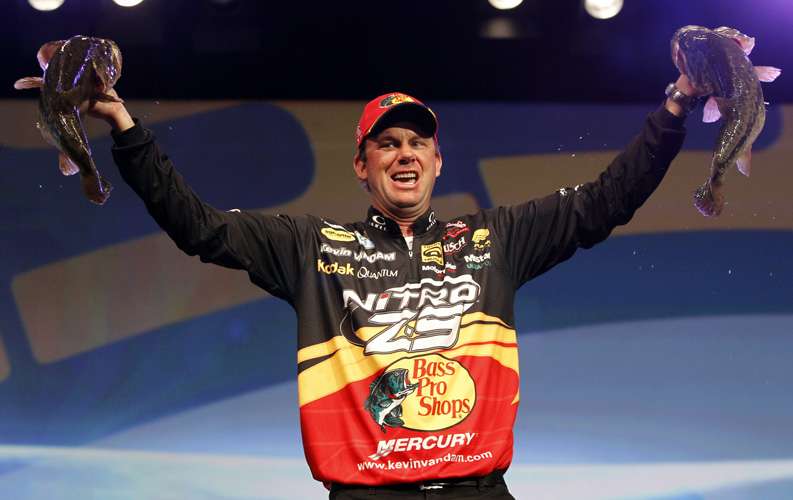
The Bassmaster Classic is different. It's not like other tournaments. It's not even like other championships.
There is more preparation, more energy expended and there are more distractions at the Classic than any other fishing tournament. It's frequently called the Super Bowl of Bass Fishing, but it's much more important than that. The Super Bowl is a team event. An individual player — even an important player, like the quarterback — can have a mediocre or bad day and still win if someone else picks up the slack.
That's not true in the Classic. There's no room for failure and little opportunity to make up for a bad day. It's often said (and generally true) that you can't win the Classic in one day but you can certainly lose it.
Another reason the Classic is more important than the Super Bowl is the money — $300,000 to the winner. The disparity between the winner's check and the runner-up check is one of the big reasons anglers say there's no second place in the Classic. Not only do few remember the "first loser," but when you're getting so much less than the winner, second is no prize.
But the check is just the beginning. A Classic champ can earn much more on the back end, in bonuses, endorsements, appearance fees and the like. Being the world champion is something that can never be taken away from you. You wear the title forever and it pays big dividends. Just ask Bobby Murray if that first Classic championship ended up paying him more than just the $10,000 winner's check.
Here are a few tips for watching Day 1 of the Bassmaster Classic. Some apply to any tournament, but they may change the way you see the championship.
Leaders without limits
Beware the anglers who come in on Day 1 with anything less than five keeper bass, even if one of those anglers takes the opening round lead. Anything less than a limit is a bad omen.
If a competitor doesn't have a five bass limit on the first day, he's in trouble. He's probably not on the fish he needs to win, and on Day 2 he'll likely be scrambling to stay in the hunt. If the Day 1 leader has just four bass and there are 10 anglers chasing him who all have limits, you can just about count on the leader being run down and passed in the second round.
Lunkers lie
Similarly, if the leader on Day 1 has 20 pounds, but eight of those pounds are in one bass and the other four weigh three pounds apiece, don't jump on that angler's bandwagon just yet. A big fish like that is great, but the other four fish tell an important story. Take their average and see where that puts the angler. If he's still high on the leaderboard, he's a threat. If not, expect him to fall over the next two days when he can't land another big one.
Yes, Classic champs do catch lunkers, but most often they catch bass that are just heavier than average, and they limit every day. Sixteen times in 43 previous Classics, the eventual winner caught one of the daily lunkers. That's a lot, but it's not something you can point to as an indicator of who's going to win.
Get out the forks
On the first day of every Classic more than half the field is eliminated. I don't care what they tell you anywhere else about how you can never count this guy or that guy out or how it's still "anyone's tournament." That's garbage. When Day 1 is in the books it's all over for most of the field. The dream will have to wait for another year.
The biggest comeback from a Day 1 deficit in Classic history came in 1972. After the first round, Don Butler found himself in 14th place (out of 24 anglers) and 12 pounds, 13 ounces off the lead. He rebounded on Day 2 and ended up winning by more than 13 pounds.
That will never happen again. The field is too good now, there are too many competitors with the talent to win. That wasn't the case in 1972. More importantly, the creel limit was 10 bass in 1972; it's five bass now. The more bass you can keep, the more ground you can make up.
And the problem isn't just the gap between first and 14th or even 20th, it's also the number of competitors between the leader and that spot. An individual angler mired in 15th place might be able to overtake the first day leader (if the leader stumbles), but it's extraordinarily unlikely that he can also outpace all the anglers between him and the first spot. That's the "leapfrog factor," and it's a killer.
In 43 previous Classics, at the end of the first day the eventual winner is already in the lead 28 percent of the time. He's in the top three 53 percent of the time and in the top ten 93 percent of the time. You can put a fork in the anglers ranking lower than that … they're done.
Look beyond the stage
Just exactly who is in the hunt is extremely interesting at any Classic. Four times in the last dozen years it was the Kevin VanDam show, and if you see him at or near the lead at the end of the first round, look out! He knows how to manage that situation better than anyone else in the world.
But if the leader is almost anyone else, their challenge may just be beginning. For example, let's imagine that one of the B.A.S.S. Nation qualifiers is leading on Day 1. Well, you can bet that he was alone on the water — just him, his Classic dreams and an observer. As word got out that he was catching them, he was probably joined by a television cameraman, but there were almost certainly no boats following him out there.
It's a different story the next day. He's going to draw a crowd — not a KVD crowd of a hundred or more boats, but a crowd nonetheless.
Can his fish withstand that kind of intrusion? Will the boat pressure kill his bite? Will all the electronics from the other boats make his fish skittish?
If he's lucky, KVD, Skeet Reese and Mike Iaconelli will be near the top, too, and will be pulling the majority of the spectator boats their way. If not, things could get ugly.
It gets even more interesting on Day 2, but we'll cover that tomorrow.

